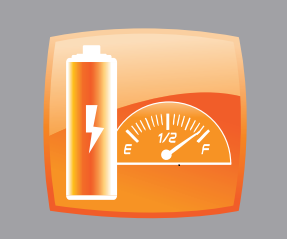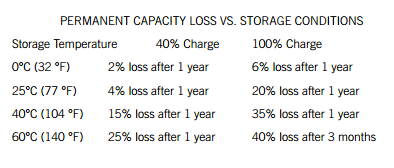Powering Your Printer: What You Need to Know About Lithium-Ion Batteries
 Datamax-O’Neil printers are powered by lithium-ion batteries. Lithium-ion is the fastest growing battery chemistry type in the world. In less than two decades, it has progressed from the research and development domain to more widespread use, to the point that they are rapidly becoming the world’s most popular portable secondary battery chemistry. They’re the battery of choice in everything from cell phones and digital cameras to printers and portable PCs and tablets. Lithium-ion batteries are a family of rechargeable batteries in which lithium ions move from the negative electrode to the positive electrode when discharging, and in the opposite direction when charging. They have been referred to as “rocking chair batteries†because of the back-and-forth ionic action during charge and discharge.
Datamax-O’Neil printers are powered by lithium-ion batteries. Lithium-ion is the fastest growing battery chemistry type in the world. In less than two decades, it has progressed from the research and development domain to more widespread use, to the point that they are rapidly becoming the world’s most popular portable secondary battery chemistry. They’re the battery of choice in everything from cell phones and digital cameras to printers and portable PCs and tablets. Lithium-ion batteries are a family of rechargeable batteries in which lithium ions move from the negative electrode to the positive electrode when discharging, and in the opposite direction when charging. They have been referred to as “rocking chair batteries†because of the back-and-forth ionic action during charge and discharge.
Chemistry, performance, cost, and safety characteristics vary across lithium-ion battery types. Unlike disposable lithium primary batteries, lithium-ion electrochemical cells use an intercalated lithium compound as the electrode material instead of metallic lithium. The positive electrode material is typically a metal oxide with a layered structure, such as lithium cobalt oxide (LiCoO2), or a material with a tunneled structure, such as lithium manganese oxide (LiMn2O4), on a current collector of aluminum foil. The negative electrode material is typically a graphitic carbon (also a layered material) on a copper current collector. In the charge/discharge process, lithium ions are inserted or extracted from interstitial space between atomic layers within the active materials.
Advantages Over Older Technologies
The advantages of lithium-ion batteries over older battery chemistries are considerable:
- They are much lighter than other energy-equivalent secondary batteries.The capacity per weight ratio has improved as the chemistry has evolved. From a printing standpoint, this means the ability to produce more labels and receipts with less frequent charging of the device.
- Compared to lead acid, nickel-metal hydride (NiMH), and nickel cadmium (NiCd) batteries, lithium-ion ones have significantly higher open circuit voltage. This is important because it increases the amount of power that can be transferred at low current. They have a nominal open circuit of 3.6 V and a typical charging voltage of 4.2 V. The charging procedure is one of constant voltage with current limiting. This means charging with constant current until the cell reaches a voltage of 4.2 V and continuing with a constant voltage until the current drops close to zero. (Typically the charge is terminated at 7 percent of the initial charge current.) In the past, lithium-ion batteries could not be fast-charged and needed at least two hours to fully charge. Current generation cells can be fully charged in 45 minutes or less; some reach 90 percent in as little as 10 minutes.
- They have long cycle life, typically 500 cycles.
- They have long shelf life. A unique characteristic of the lithium-ion battery is that its life span depends on aging from time of manufacturing (regardless of whether it was charged) and not just on the number of charge/discharge cycles. Consequently, lithium-ion batteries should be purchased only when needed.
- Lithium-ion batteries offer a broad temperature range of operation (charge at –20°C to 60°C; discharge at –40°C to 65°C), enabling their use in a wide variety of applications, and making them ideal for printers in virtually every environment.
- There is no memory effect in terms of performance deterioration. Even so, lithium-ion batteries with fuel gauges exhibit what engineers refer to as “digital memory.†Discharges with subsequent recharges do not provide the periodic calibration needed to synchronize the fuel gauge with the battery’s state-of-charge. Discharging and recharging the battery completely after every 30 charges corrects this problem. Letting the battery run down to the cut-off point in the equipment will do this. If ignored, the fuel gauge will become increasingly less accurate. (We do not implement a fuel gauge in lithium-ion batteries used in our printers, so this full discharge process is unnecessary.)
- Lithium-ion batteries have a low self-discharge rate compared to other battery chemistries. In “smart†lithium-ion batteries, this discharge results from the drain of the built-in voltage monitoring circuit. Batteries without these circuits have no self-discharge in the usual meaning of the term.
- Since no free lithium metal is used in these batteries, they are comparatively environmentally safe.
- The range of lithium-ion battery shapes and sizes ensures efficient fit with the devices they power. They are sealed cells, requiring no maintenance.
Storage Temperature and Charge
Storing a lithium-ion battery at the correct temperature and charge makes a significant difference in maintaining its storage capacity. The following table shows the amount of permanent capacity loss that will occur after storage at a given charge level and temperature.

It is significantly beneficial to avoid storing a lithium-ion battery at full charge; one stored at 40 percent charge will last many times longer, particularly at higher temperatures.
A lithium-ion battery stored with too low a charge risks a drop below the battery’s low-voltage threshold, resulting in an unrecoverable dead battery. Once the charge has dropped to this level, recharging it can be dangerous. An internal safety circuit will therefore open to prevent charging, rendering the battery useless.
Preserving Batteries in Printing Applications
The biggest power draw in thermal printing applications is the printer itself. The three principal areas of the printing system consuming the battery are the print head, radio, and main circuit board.
There are a number of practical means to prolong battery life:
- Optimize label formats - The less black printed, the less energy used; make sure that only the information needed is printed, and that the label is sized efficiently for this. Printing excess information or across a larger area than needed wastes battery power.
- Assess your communications protocols - Do you really need to use an 802.11 communications protocol? If so, this will consume the most power. If you can use a Bluetooth environment instead of an 802.11 network, you’ll get more labels from the printer per battery and reduce power consumption. Always print at the highest speed to consume less energy.
- Optimize utilization practices - Turn the printer off when it is not in use. Use the standby mode built into the printer so it will go into low power when not in operation and reduce the power draw.
- Be conscious of temperature -Â Stay away from cold environments if possible. If the print head gets cold, it needs to draw more power to heat up to requisite temperatures. So instead of printing in the back of a truck, print in the cab or indoors at the site to save energy. A protective case will help keep the printer warmer and extend battery life.
- Watch for performance degradation -Â A drop in the amount of labels per charge or a noticeable change in the print speed are usually indications to change the battery.
Closing Considerations
Avoid frequent full discharges because it puts additional strain on the battery. Several partial discharges with frequent recharges are better for lithium-ion than one deep one. Recharging a partially charged lithium-ion does not cause harm because there is no memory. Short battery life is typically caused by heat rather than charge/discharge patterns.
Dispose of your batteries properly. While lithium-ion batteries are not yet classified as hazardous waste by the United States government, there are many reasons to recycle these batteries. In many states, it is illegal to throw away lithium ion batteries because they enter the solid waste stream and contaminate soil and water. Exposure to the elements in these batteries can lead to respiratory problems and, in some cases, skin rashes. In addition, if this kind of battery is subjected to high temperatures, it may explode. To locate a recycling center in the United States near you, call 1-800-8-BATTERY or 1-877-2-RECYCLE.




